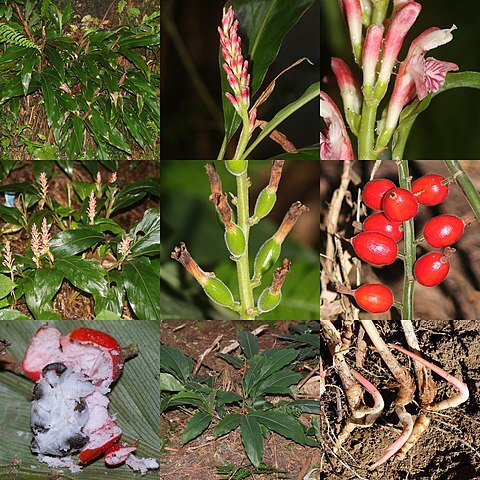Pseudostems 35--70 cm. Ligule 2-cleft, ca. 2 mm, pubescent; petiole to 2 cm; leaf blade lanceolate, oblanceolate, or narrowly long elliptic, 25--40 × 4--7 cm, pubescent especially abaxially, base attenuate, apex acuminate, mucronate. Racemes 15--30 cm; rachis densely tomentose; involucral bracts lanceolate, ca. 9 cm, deciduous at anthesis; bracteoles very small, early deciduous. Flowers usually paired on rachis, often also with degenerate flowers; pedicel ca. 2 mm. Calyx clavate, 1--1.2 cm, pubescent, apex 3-toothed. Corolla tube ca. 1 cm, sparsely puberulent; lobes oblong, ca. 1 cm, abaxially tomentose, central one hoodlike. Lateral staminodes linear, ca. 5 mm. Labellum white marked with red stripes, ovate, ca. 6 mm wide, margin irregularly notched, apex 2-cleft. Stamen 1.2--1.4 cm. Ovary densely tomentose. Capsule salmon red, globose or ellipsoid, 1--1.5 cm in diam., pubescent, apex with persistent calyx. Seeds ca. 5 × 3 mm, many angled, with camphorlike odor. Fl. Apr--Aug, fr. Jul--Dec. 2 n = 48*.
More
A ginger family herb. The false stem is 35-70 cm high. The leaf stalk is about 2 cm long. The leaf blade is sword shaped and 25-40 cm long by 4-7 cm wide. It is hairy especially underneath. It tapers to the tip. The flower racemes are 15-30 cm long. The flowers are usually paired along this stalk. The flowers are white with red marks. The fruit is a capsule which is red and round. It is 1-1.5 cm across. It is hairy. The seeds are 5 mm by 3 mm and with many angles.

